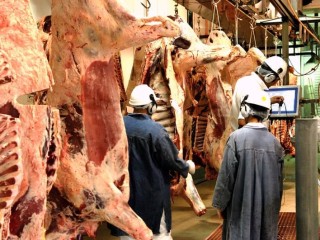 Australian beef exports to the US have collapsed to their lowest point in 20 years, under the combined weight of an historically high A$ and strong US domestic manufacturing beef supply which is keeping grinders out of the imported beef market.
Australian beef exports to the US have collapsed to their lowest point in 20 years, under the combined weight of an historically high A$ and strong US domestic manufacturing beef supply which is keeping grinders out of the imported beef market.
Latest trade figures released on Tuesday reveal that Australian shipments to the US for the six-month period to the end of April were less than 66,500 tonnes. That’s a 23 percent decline in trade compared with the same period last year when 85,400t was consigned, and a Grand Canyon-sized drop from the 156,000t for the corresponding six-month period in 2008-09.
The total calendar year shipment figure to the US for 2010 was 195,000t, and that figure is likely to drop much further in 2011, analysts say. That’s a far cry from the two consecutive years in 2002-03 when Australia broke-through the US beef quota limit of 378,000t.
Once one of the cornerstones of Australia’s beef export trade, the US is now in danger of slipping into ‘second-tier’ status among our beef export customers, statistics suggest. Korea (75,000t for the latest six months this year, up from 58,000t in 2010) has now gone well past the US in volume, and the EU/CIS/other Europe is not far behind (44,000t so far this year).
A big culprit behind the savage drop in trade into the US is the recent surge in the value of the A$ (quoted in today’s BeefCentral graph at US108.5c), which is making Australian product much less competitive in North America than it was a year ago.
“The dollar is simply making it more viable for Australian exporters to sell that product elsewhere,” the Australian Meat Industry Council’s national director, processing, Steve Martyn said.
One of the outcomes of this was a dramatic decline in Australia’s chilled beef exports to the US. At one point Australia was exporting more than 30,000t of chilled beef to the US each year, in addition to the dominant frozen manufacturing beef trade. That’s now been cut by at least two-thirds, with most of the chilled product now heading into Japan.
Many exporters are unhappy with that development, however, because one of the big drivers behind cultivating the chilled trade into the US over the past 8-10 years has been in providing an export marketing alternative other than Japan, to give Australia stronger leverage during price negotiation.
In manufacturing beef, both Japan and Korea take substantial quantities of frozen grinding beef, some of which is currently being diverted due to the lower trade patterns into the US. Australia’s shipments to Japan for frozen/chilled combined for the six months to the end of April this year were just over 170,000t. That figure is almost identical to the same period last year, and in 2009.
In the absence of any quota application issue into the US at present, the export market is simply reflecting the best return on the day for any given product, Mr Martyn said. Another consideration was the ‘risk’ attached to export to the US versus alternate markets for the same product through regulatory measures. Tests for e.coli, at exporter expense, and potentially lengthy delays or rejection do not apply in alternate markets for the sale product like Russia or Indonesia.
“But the US market is not gone forever. It will definitely come back more strongly into calculations for the Australian industry,” Mr Martyn said.
“The US beef herd is at a 50-year low, and domestic prices are being maintained through a heavy cow kill – but that cannot go on forever. When the US herd rebuilding phase does activate, prices for domestic 90CL beef will go up. As long as the A$ does not continue to climb, there will be a price point where imported Australian 90CL becomes more attractive again,” he said.
